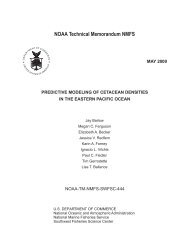NOAA Technical Memorandum NMFS - Southwest Fisheries ...
NOAA Technical Memorandum NMFS - Southwest Fisheries ...
NOAA Technical Memorandum NMFS - Southwest Fisheries ...
You also want an ePaper? Increase the reach of your titles
YUMPU automatically turns print PDFs into web optimized ePapers that Google loves.
species over long ranges, at night, and in poor weather conditions where visual<br />
observations may be of little use.<br />
F. Hull-mounted Hydrophone Detections<br />
The hull-mounted hydrophones provided a simple means of obtaining recordings<br />
of bow-riding dolphins, and other species in close proximity to the bow of the ship. At<br />
full speed, there was increased noise from bow waves, and from the anchor hitting the<br />
hull of the ship. Nonetheless, we now have numerous high-quality recordings of many<br />
species recorded using the bow hydrophone. Recordings from the bow hydrophone<br />
played an important role in analysis of the initial B. acutorostrata ‘boing’ detection<br />
(Rankin and Barlow 2005a). Likewise, opportunistic recordings of a group of M.<br />
densirostris which dove 100 m off the bow provided a previously undescribed midfrequency<br />
vocalization produced by these animals (Rankin and Barlow 2007a). These<br />
are the only two hull-hydrophone recordings that have been analyzed. This hydrophone<br />
can provide some information on vocalizing animals ahead of the ship that we are unable<br />
to detect using the towed hydrophone array. While this hydrophone can provide highquality<br />
opportunistic recordings, it appears to have a low range of detection at survey<br />
speeds. At slow speeds, the hull hydrophones may be useful for acoustic detections and<br />
mitigation using passive acoustic methods.<br />
V. CONCLUSION<br />
The basic goals of this study were to determine the potential role that passive<br />
acoustic detection methods may play in future line-transect cetacean surveys, and to<br />
obtain additional information regarding the acoustic detection of sperm whales. The<br />
preliminary results presented here, as well as the numerous publications, reports, and<br />
presentations given in the Appendix, indicate the great effectiveness of acoustic methods<br />
for ship-board surveys. There are still innumerable questions regarding the variability in<br />
the acoustic detection of cetaceans, but there is no doubt that ship-based surveys of<br />
cetaceans greatly benefit from the use of passive acoustics. This is especially true in<br />
tropical waters, where highly vocal whistling dolphin species are common.. Sufficient<br />
information on the acoustic detection of sperm whales, P. macrocephalus, has been<br />
obtained for passive acoustics to be incorporated into the standard protocols for linetransect<br />
surveys run by SWFSC. Results from these surveys suggest that the passive<br />
acoustic detection of minke whales, B. acutorostrata, may be essential for estimating<br />
population size in tropical and sub-tropical waters.<br />
Patterns in passive acoustic detection of delphinids are more complicated.<br />
Passive acoustic monitoring must include precise localization to estimate the position of<br />
vocalizing groups. There were many occasions in which acoustic localization of<br />
vocalizations indicated that the sounds were produced from a different group than those<br />
sighted by the visual observers. Likewise, localization allowed for detection of additional<br />
subgroups within a sighting that were not detected by the visual observation team.<br />
Passive acoustic monitoring should allow for detection of high frequency<br />
vocalizations, especially in temperate waters.<br />
There are two critical limitations in this dataset. First, the methods for monitoring<br />
were limited to frequencies below 24 kHz. In many cases recordings of higher<br />
frequencies were made, but these higher frequencies were not included in this analysis.<br />
17









